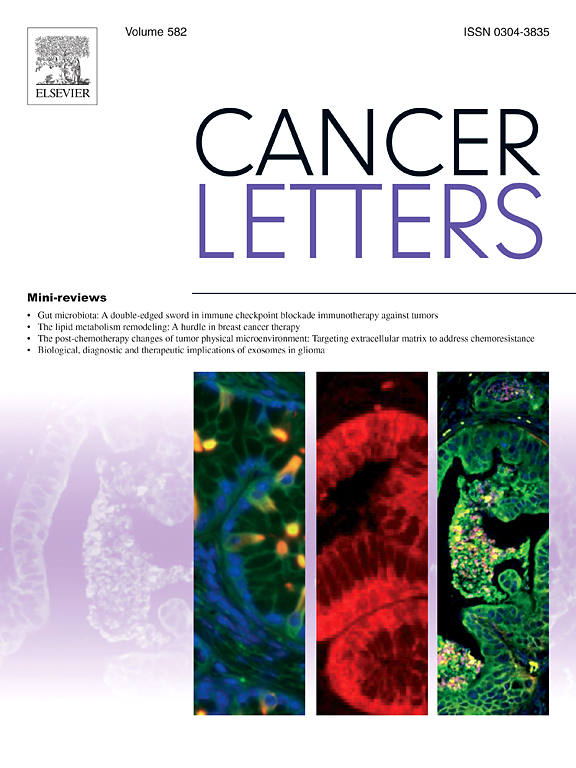ADAMs通过mTORC1通路参与三阴性乳腺癌:靶向ADAM-mTOR轴可提高疗效
IF 9.1
1区 医学
Q1 ONCOLOGY
引用次数: 0
摘要
乳腺癌是全球最常见的癌症,也是美国女性癌症相关死亡的第二大原因。三阴性乳腺癌(TNBC)缺乏雌激素受体、孕激素受体和人表皮生长因子受体2。因此,针对这种最具侵袭性的亚型,可用的靶向治疗方法较少。A崩解素和金属蛋白酶(ADAM)家族在肿瘤病理生理中起着重要作用。以前的研究主要集中在单个ADAM成员身上。然而,这些都没有进入临床领域作为乳腺癌的诊断或治疗方法。在这项研究中,我们证明了TNBC中一组ADAM成员的上调,并且所有测试的个体ADAMs的过表达与患者生存率低相关,因此靶向单个ADAM成员不太可能有效。反相蛋白阵列和多路免疫荧光显示ADAM10/15/17的表达与mTOR信号激活有关。单独敲低ADAM10、ADAM15或ADAM17可适度降低mTOR信号传导、细胞增殖和存活。然而,同时敲低这三个ADAMs会显著降低mTOR信号传导和细胞侵袭性。与单药治疗相比,ADAMs和mTOR联合靶向在体外以及免疫缺陷和免疫正常小鼠中对adam -mTOR激活的肿瘤生长和侵袭的抑制效果始终如一。这些结果建立了ADAMs和mTOR信号激活之间的功能联系,表明ADAM-mTOR轴可作为富含ADAM的TNBC的治疗靶点和生物标志物,并可能用于其他具有高ADAM活性的肿瘤谱系。本文章由计算机程序翻译,如有差异,请以英文原文为准。
ADAMs contribute to triple negative breast cancer via mTORC1 pathway: targeting ADAM-mTOR axis improves efficacy
Breast cancer is the most frequently diagnosed cancer globally and the second leading cause of cancer-related deaths in American women. Triple-negative breast cancer (TNBC) lacks estrogen receptor, progesterone receptor, and human epidermal growth factor receptor 2. Thus, fewer targeting therapies are available for this most aggressive subtype. The A Disintegrin and Metalloproteinase (ADAM) family plays a vital role in cancer pathophysiology. Previous studies focused on single ADAM members. However, none of these have entered into the clinical arena as diagnostics or therapeutics for breast cancer. In this study, we demonstrate the upregulation of a panel of ADAM members in TNBC, and overexpression of all the individual ADAMs tested are correlated with poor patient survival, making it unlikely that targeting a single ADAM member would be effective. Reverse-phase protein array and multiplexed immunofluorescence revealed that ADAM10/15/17 expression was associated with activated mTOR signaling. Individual knockdown of ADAM10, ADAM15, or ADAM17 modestly reduced mTOR signaling, cellular proliferation and survival. However, the concurrent knockdown of the three ADAMs drastically decreased mTOR signaling and cellular aggressiveness. Consistently, combined targeting of ADAMs and mTOR increased inhibitory efficacy compared to monotherapy in ADAM-mTOR-activated tumor growth and invasion in vitro and in immunodeficient and immunocompetent mice. These results establish a functional link between ADAMs and activation of mTOR signaling, suggesting the ADAM-mTOR axis as a therapeutic target and biomarker for ADAM-enriched TNBC and, potentially, other tumor lineages with high ADAM activity.
求助全文
通过发布文献求助,成功后即可免费获取论文全文。
去求助
来源期刊

Cancer letters
医学-肿瘤学
CiteScore
17.70
自引率
2.10%
发文量
427
审稿时长
15 days
期刊介绍:
Cancer Letters is a reputable international journal that serves as a platform for significant and original contributions in cancer research. The journal welcomes both full-length articles and Mini Reviews in the wide-ranging field of basic and translational oncology. Furthermore, it frequently presents Special Issues that shed light on current and topical areas in cancer research.
Cancer Letters is highly interested in various fundamental aspects that can cater to a diverse readership. These areas include the molecular genetics and cell biology of cancer, radiation biology, molecular pathology, hormones and cancer, viral oncology, metastasis, and chemoprevention. The journal actively focuses on experimental therapeutics, particularly the advancement of targeted therapies for personalized cancer medicine, such as metronomic chemotherapy.
By publishing groundbreaking research and promoting advancements in cancer treatments, Cancer Letters aims to actively contribute to the fight against cancer and the improvement of patient outcomes.
 求助内容:
求助内容: 应助结果提醒方式:
应助结果提醒方式:


